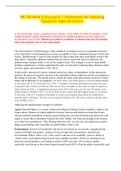Samenvatting
Summary Exam notes for Methods of Communication Research and Statistics (MCRS) second exam
- Instelling
- Universiteit Van Amsterdam (UvA)
Providing all relevant and comprehensive content for Methods of Communication Research and Statistics second exam (week 8-week 12). Content covers the book, lectures, and all other relevant material.
[Meer zien]













